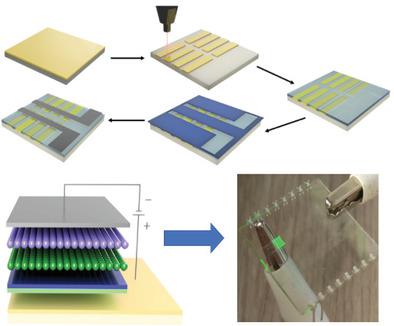当前位置:
X-MOL 学术
›
Adv. Funct. Mater.
›
论文详情
Our official English website, www.x-mol.net, welcomes your
feedback! (Note: you will need to create a separate account there.)
Low-Temperature Solution-Processed Transparent QLED Using Inorganic Metal Oxide Carrier Transport Layers
Advanced Functional Materials ( IF 18.5 ) Pub Date : 2021-09-15 , DOI: 10.1002/adfm.202106387 Yang Yu 1 , You Liang 1 , Jason Yong 1 , Tianzhi Li 1 , Md Sharafat Hossain 1 , Yutong Liu 1 , Yihong Hu 2 , Kumaravelu Ganesan 1 , Efstratios Skafidas 1
Advanced Functional Materials ( IF 18.5 ) Pub Date : 2021-09-15 , DOI: 10.1002/adfm.202106387 Yang Yu 1 , You Liang 1 , Jason Yong 1 , Tianzhi Li 1 , Md Sharafat Hossain 1 , Yutong Liu 1 , Yihong Hu 2 , Kumaravelu Ganesan 1 , Efstratios Skafidas 1
Affiliation

|
Quantum dot light-emitting diodes (QLEDs) represent an exciting new technology that has many desirable attributes when compared to existing organic LEDs (OLEDs) including increased brightness, contrast, and response time. Solution-based fabrication approaches have the advantage of being able to produce large-area electronic systems at reduced costs and critical in applications such as large display fabrication and electronics on curved surfaces including low-profile augmented reality glasses. In this paper, for the first time, a fully solution-processed transparent inorganic QLED is described. Traditional QLED fabrication methodologies require the use of air-sensitive materials that make fabrication of these devices challenging and expensive. Instead of using air-sensitive organic materials, in the approach, nickel oxide (NiO) is used as the hole transport layer and is deposited using a sol-gel method. Copper doping of the NiO to reduce the turn-on voltage of the QLED device is investigated. Importantly, the post-annealing temperature of the sol-gel process is below 275 °C, which permits the fabrication of QLEDs on a wide range of substrates. The experimental results are concordant with the COMSOL simulation data and demonstrate the feasibility of fabricating fully transparent inorganic QLED devices using a solution-based process.
中文翻译:

使用无机金属氧化物载体传输层的低温溶液处理透明 QLED
量子点发光二极管 (QLED) 代表了一种令人兴奋的新技术,与现有的有机 LED (OLED) 相比,它具有许多理想的属性,包括增加的亮度、对比度和响应时间。基于解决方案的制造方法的优势在于能够以较低的成本生产大面积的电子系统,并且在大型显示器制造和曲面电子设备(包括薄型增强现实眼镜)等应用中至关重要。在本文中,首次描述了一种完全溶液处理的透明无机 QLED。传统的 QLED 制造方法需要使用对空气敏感的材料,这使得这些设备的制造具有挑战性且成本高昂。在这种方法中,不是使用对空气敏感的有机材料,氧化镍 (NiO) 用作空穴传输层并使用溶胶-凝胶法沉积。研究了 NiO 的铜掺杂以降低 QLED 器件的开启电压。重要的是,溶胶-凝胶工艺的后退火温度低于 275 °C,这允许在各种基板上制造 QLED。实验结果与 COMSOL 仿真数据一致,证明了使用基于溶液的工艺制造全透明无机 QLED 器件的可行性。
更新日期:2021-09-15
中文翻译:

使用无机金属氧化物载体传输层的低温溶液处理透明 QLED
量子点发光二极管 (QLED) 代表了一种令人兴奋的新技术,与现有的有机 LED (OLED) 相比,它具有许多理想的属性,包括增加的亮度、对比度和响应时间。基于解决方案的制造方法的优势在于能够以较低的成本生产大面积的电子系统,并且在大型显示器制造和曲面电子设备(包括薄型增强现实眼镜)等应用中至关重要。在本文中,首次描述了一种完全溶液处理的透明无机 QLED。传统的 QLED 制造方法需要使用对空气敏感的材料,这使得这些设备的制造具有挑战性且成本高昂。在这种方法中,不是使用对空气敏感的有机材料,氧化镍 (NiO) 用作空穴传输层并使用溶胶-凝胶法沉积。研究了 NiO 的铜掺杂以降低 QLED 器件的开启电压。重要的是,溶胶-凝胶工艺的后退火温度低于 275 °C,这允许在各种基板上制造 QLED。实验结果与 COMSOL 仿真数据一致,证明了使用基于溶液的工艺制造全透明无机 QLED 器件的可行性。











































 京公网安备 11010802027423号
京公网安备 11010802027423号